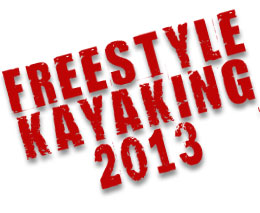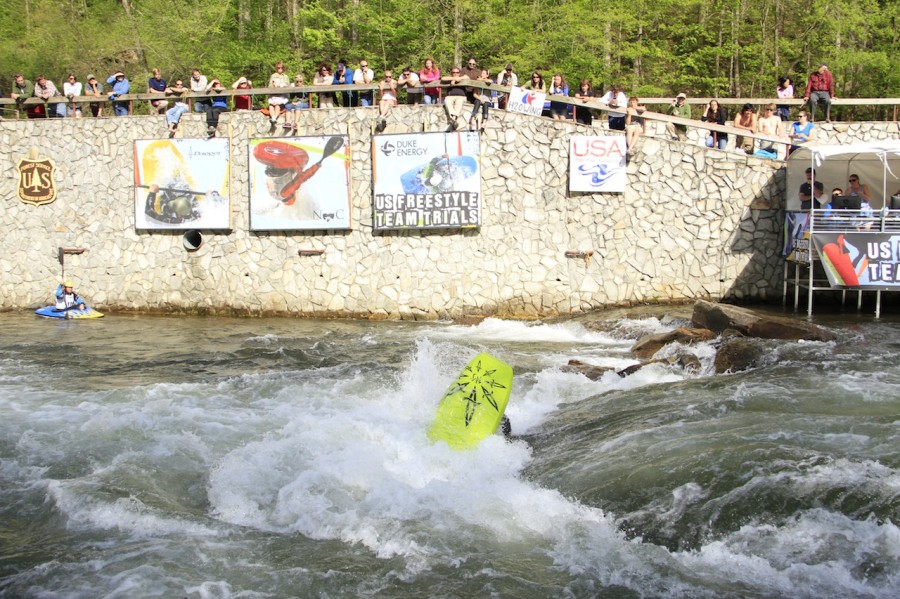Freestyle kayaking is a facet of whitewater kayaking where paddlers surf waves or holes and perform tricks. It’s an incredibly dynamic sport requiring great precision and technique, along with a high dedication to learning the sport. Since the sport takes place on rivers, where no two features are the same there are a whole host of styles and tricks that vary depending on the characteristics of the river. All in all, it’s an impressive display of athletic precision and ability each time a paddler takes a ride.
This sport is a small, but growing subset of kayaking. Many people aren’t familiar with freestyle kayaking, the terminology, or exactly what they’re seeing when they watch freestyle kayaking. Let this article be a guide for understanding the sport a little better.
The Kayaks
Paddlers use freestyle kayaks or playboats. These are small crafts that can be easily thrown around and are highly maneuverable. Boats are typically around 6 feet long and a little more than two feet wide. They are outfitted with seats, back bands, and thigh braces to keep the paddler tight in the boat. Most paddlers prefer to be tightly secured in their boat so it reacts to every little motion effectively.
Most playboats are made out of plastic and typically weigh between 25-30 pounds. However, in recent years many paddlers have been turning to boats made of carbon fiber. These boats are significantly lighter, around 15 pounds, and are more rigid. This combination of less weight and more rigidity allow for paddlers to catch more air on their tricks and throw their boat around with more ease. The trade off is that carbon boats are more fragile than plastic boats, and in freestyle kayaking, coming in contact with rocks happens from time to time.
The Features
Freestyle kayaking takes place on a wide variety of river features, and even in flatwater. While freestyle kayaking is certainly not limited to any one spot, freestyle competitions take place at one feature at a river. The features are either a wave or a hole. Most people know waves and holes more generally as hydraulics. In short, a hole or wave is formed by water flowing over rocks that drop, this drop in the rocks causes water to recirculate and flow back upstream to fill in the void created by the drop in rocks. By having water moving back upstream these river features allow paddlers to stay in place and surf.
So what’s the difference between a wave and hole? Waves are just like one would expect from an ocean wave, except the wave is stationary on the river. Waves can be anywhere from a few inches tall to 20-30 feet tall (or taller!) on high volume rivers. A hole is a smaller feature with more recirculating water. Both features allow for a different range of tricks.
The Tricks
The whole purpose of freestyle kayaking is to perform tricks. Understanding the basic tricks is the easiest place to start. The most basic tricks are spins, cartwheels, and loops. Most advanced tricks are variations or combinations of these few building blocks. A spin is just a flat 360 degree rotation while surfing on a feature. Cartwheels are spins with at least 45 degrees of elevated angle. Loops are front flips in a kayak. These are really just the tip of the iceberg, but if you can understand those basics, most tricks are variations from these.
Competition
Freestyle kayaking competition is a timed event. Each rider gets a 45 second ride to score as many tricks in that ride as possible. Features are deemed attainable or non attainable, determining if paddlers can paddle back up to the feature to continue their ride if they flush. Paddlers score points by performing each trick successfully. Each trick will only be scored once per ride, encouraging a wide range of tricks for each ride. The harder the trick, the more points it scores. Paddlers are awarded bonuses for catching more air, performing a trick without using their paddle (clean bonus), and for linking multiple moves together.
There is a panel of 5 judges, with a head judge to oversee the judges and ensure consistent judging and settle any disputes amongst judging.
There are a mens, womens, junior mens, and junior womens classes. Beyond that, there are kayak (K-1), closed deck canoe (C-1), Open Canoe (OC-1) divisions.
With these basics the world of freestyle kayaking can be more approachable. There is a lot more to learn and discover about this sport, and the best way to do so is head to a competition and see for yourself. The world of freestyle kayaking is very social, and while it is a highly competitive sport, it is not at the expense of friendships and respect amongst paddlers. Come on down to the river, meet some paddlers, watch them go head to head with their best tricks, and we’ll see you there!






